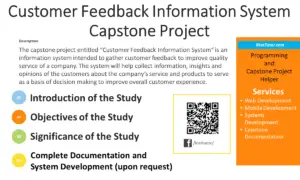Business Analytics and Intelligence Project Ideas
Introduction
Table of Contents
In today’s competitive business landscape, Business Analytics (BA) and Business Intelligence (BI) have emerged as critical tools for organizations seeking to gain a strategic edge. While BA focuses on the use of data analysis and statistical models to drive decision-making, BI leverages data visualization, reporting, and querying tools to provide actionable insights. Together, these disciplines empower businesses to transform raw data into valuable information, enabling them to make informed decisions that can lead to significant competitive advantages.
The importance of data-driven decision-making in modern businesses cannot be overstated. In an era where data is often referred to as “the new oil,” organizations that effectively harness and analyze data are better positioned to understand market trends, identify opportunities, and anticipate challenges. By basing decisions on data rather than intuition alone, businesses can minimize risks, optimize operations, and improve customer satisfaction.
Moreover, business analytics and intelligence can drive growth, efficiency, and innovation across all sectors. From enhancing marketing strategies and optimizing supply chains to predicting customer behavior and improving financial performance, BA and BI provide the insights necessary to innovate and stay ahead of the competition. As businesses increasingly recognize the value of data, the adoption of BA and BI practices is becoming not just a competitive advantage but a necessity for sustained success.
What is Business Analytics and Intelligence?
Business Analytics (BA) and Business Intelligence (BI) are complementary disciplines that play a crucial role in helping organizations make data-driven decisions. Both fields focus on leveraging data to gain insights, but they do so in slightly different ways.
Definition of Business Analytics (BA)
Business Analytics (BA) refers to the systematic exploration of an organization’s data, often using statistical analysis, predictive modeling, and data mining techniques. The goal of BA is to generate actionable insights that can help predict future trends, identify opportunities, and optimize processes. BA is typically forward-looking, focusing on predicting outcomes and supporting strategic planning.
Definition of Business Intelligence (BI)
Business Intelligence (BI) involves the use of tools and techniques to collect, process, and present data in a way that is easily understandable and actionable. BI primarily focuses on historical data, providing descriptive insights through dashboards, reports, and data visualizations. The purpose of BI is to support decision-making by offering a clear picture of what has happened in the past and what is currently happening within the organization.
Differences and Similarities between BA and BI
While both BA and BI are data-driven disciplines, they differ in their primary focus and methodologies:
- Focus:
- BI is concerned with the “what” and “how” of past and present data. It helps businesses understand what has happened by analyzing historical data.
- BA focuses on the “why” and “what if” aspects, using data to forecast future trends and determine the best course of action.
- Methodology:
- BI relies on descriptive analysis, using dashboards, reports, and visualizations to provide insights into past performance.
- BA uses predictive and prescriptive analytics, applying statistical models, machine learning, and optimization techniques to predict future outcomes and suggest actions.
- Tools:
- BI tools include data warehouses, OLAP (Online Analytical Processing), and dashboarding software (e.g., Power BI, Tableau).
- BA involves tools like R, Python, and advanced analytics platforms (e.g., SAS, IBM SPSS) that support complex modeling and analysis.
Despite these differences, BA and BI share the common goal of enhancing decision-making by transforming raw data into meaningful insights.
Key Components of a Business Analytics and Intelligence System
A robust Business Analytics and Intelligence system typically includes the following components:
- Data Sources:
- The foundation of any BA/BI system is data, which can come from various sources such as databases, external APIs, IoT devices, and social media platforms.
- Data Warehousing:
- A data warehouse is a central repository where data from different sources is stored and organized. It enables efficient querying and reporting.
- Data Processing and ETL (Extract, Transform, Load):
- ETL processes are used to extract data from different sources, transform it into a suitable format, and load it into the data warehouse.
- Data Analytics Tools:
- Analytics tools are used to perform statistical analysis, predictive modeling, and machine learning on the processed data. These tools help in identifying patterns, correlations, and trends.
- Data Visualization and Reporting:
- BI tools and dashboards are used to create visual representations of data, making it easier for decision-makers to interpret and act on the insights.
- User Interface:
- The end-user interface, which could be a dashboard, a reporting tool, or a custom application, allows business users to interact with the data, run queries, and generate reports.
Business Analytics and Intelligence Project Ideas
Here are 15 project titles for Business Analytics and Intelligence:
- Sales Forecasting Using Machine Learning for Optimized Inventory Management
This project involves developing a machine learning model to predict future sales based on historical data. The goal is to help businesses optimize inventory levels, reduce stockouts, and minimize excess inventory, thereby improving overall operational efficiency.
- Customer Segmentation and Personalization with K-Means Clustering
This project focuses on using K-Means clustering to segment customers based on various attributes such as demographics, purchasing behavior, and preferences. The insights gained can be used to personalize marketing strategies and improve customer engagement.
- Predicting Customer Churn with Classification Algorithms
In this project, classification algorithms like decision trees, logistic regression, or random forests are used to predict which customers are likely to leave a business (churn). The goal is to identify at-risk customers early and implement retention strategies to reduce churn rates.
- Building an Executive Dashboard for Real-Time Business Intelligence
This project involves creating a real-time dashboard that provides executives with key performance indicators (KPIs) and other critical metrics. The dashboard helps decision-makers monitor business performance, identify trends, and make informed decisions quickly.
- Market Basket Analysis for Enhancing Retail Cross-Selling Strategies
This project uses market basket analysis to identify products frequently purchased together by customers. Retailers can use these insights to develop effective cross-selling strategies, such as bundling products or recommending complementary items to increase sales.
- Sentiment Analysis of Customer Feedback to Improve Product Development
This project focuses on analyzing customer feedback using sentiment analysis techniques to determine customer satisfaction and identify areas for product improvement. The insights can guide product development teams in enhancing features and addressing customer concerns.
- Financial Performance Monitoring with BI Tools: A Case Study Approach
This project involves using business intelligence (BI) tools to monitor and analyze a company’s financial performance. By examining financial ratios, trends, and metrics, the project aims to provide actionable insights for improving financial health and decision-making.
- Optimizing Supply Chain Operations Using Predictive Analytics
In this project, predictive analytics is used to forecast demand, optimize inventory levels, and streamline logistics in the supply chain. The goal is to enhance supply chain efficiency, reduce costs, and improve service levels.
- Employee Performance Tracking and Analysis Using BI Dashboards
This project involves developing a BI dashboard to track and analyze employee performance metrics. The dashboard provides managers with insights into productivity, efficiency, and areas for improvement, helping to drive better workforce management.
- Revenue Growth Forecasting Through Advanced Time Series Analysis
This project uses advanced time series analysis techniques to forecast future revenue growth based on historical financial data. The insights can help businesses plan for growth, allocate resources effectively, and set realistic financial goals.
- Designing a Data-Driven Marketing Campaign with Predictive Analytics
In this project, predictive analytics is used to design a marketing campaign that targets the right audience with the right message. By analyzing customer data, businesses can identify potential customers, predict campaign outcomes, and optimize marketing spend.
- Risk Assessment and Management with Business Intelligence Systems
This project involves using BI systems to assess and manage risks within an organization. By analyzing data related to market conditions, financial performance, and operational processes, businesses can identify potential risks and implement strategies to mitigate them.
- Developing a Customer Lifetime Value Model for Strategic Decision-Making
This project focuses on developing a model to calculate the Customer Lifetime Value (CLV), which estimates the total revenue a customer is expected to generate over their lifetime with the company. The model helps businesses prioritize customer retention efforts and make informed decisions about marketing and sales strategies.
- Implementing Data Warehousing for Enhanced Business Intelligence
This project involves designing and implementing a data warehouse to centralize and organize data from various sources. The data warehouse supports enhanced business intelligence by enabling efficient data retrieval, analysis, and reporting.
- Analyzing Consumer Behavior Patterns with Big Data Analytics
In this project, big data analytics is used to analyze large volumes of consumer data to identify behavior patterns, preferences, and trends. The insights can help businesses tailor their products, services, and marketing strategies to better meet consumer needs.
Choosing the Right Project
Selecting the right BI project is crucial for maximizing its impact on your business. Several factors should be considered when making this decision:
Factors to Consider
- Data Availability: Ensure access to reliable and sufficient data to support your project goals.
- Skill Level: Assess the team’s analytical and technical capabilities to match the project complexity.
- Business Impact: Prioritize projects with the potential to deliver significant value and return on investment.
Aligning Projects with Business Goals
A successful BI project should directly contribute to the overall business strategy. Consider the following:
- Strategic Alignment: Ensure the project aligns with the company’s mission, vision, and objectives.
- Key Performance Indicators (KPIs): Identify relevant KPIs to measure project success and impact.
- Stakeholder Involvement: Involve key stakeholders in project definition and prioritization.
Tips for Project Scoping and Planning
- Define Clear Objectives: Clearly articulate the project’s goals and desired outcomes.
- Identify Data Requirements: Determine the specific data needed and its accessibility.
- Create a Detailed Project Plan: Outline project phases, timelines, and resource allocation.
- Establish Key Milestones: Set clear checkpoints to track progress and adjust as needed.
- Build a Strong Team: Assemble individuals with the necessary skills and expertise.
By carefully considering these factors and following a structured approach, you can increase the likelihood of selecting and executing a successful BI project.
Tools and Technologies
The landscape of BI and analytics tools is vast, offering a range of options to suit different project needs and skill sets. Here are some of the most popular tools:
- Open-source tools: Python, R, SQL
- Data visualization and dashboarding: Tableau, Power BI, Looker
- Data integration and ETL: Talend, Informatica, Apache Airflow
- Cloud-based platforms: Google Cloud Platform (GCP), Amazon Web Services (AWS), Microsoft Azure
- Specialized analytics tools: SAS, SPSS, MATLAB
Recommendations for Specific Tools Based on Project Type
The choice of tools depends on factors such as project complexity, data volume, desired outcomes, and team expertise.
- Exploratory data analysis and modeling: Python, R
- Interactive dashboards and reporting: Tableau, Power BI
- Large-scale data processing: SQL, Hadoop, Spark
- Machine learning and AI: Python, R, TensorFlow, PyTorch
- Data integration and transformation: Talend, Informatica
Importance of Data Visualization and Storytelling
Effective communication of insights is crucial for driving business impact. Data visualization transforms complex data into understandable and engaging visuals. It helps uncover patterns, trends, and anomalies that might be missed in raw data.
Storytelling with data involves crafting a narrative around the insights to make them meaningful and actionable. By combining compelling visuals with a clear story, you can influence decision-making and drive positive change.
Conclusion
In today’s rapidly evolving business landscape, data has emerged as a critical asset. Business Analytics and Intelligence (BA and BI) have become indispensable tools for organizations seeking to gain a competitive edge. By harnessing the power of data, businesses can make informed decisions, optimize operations, and unlock new growth opportunities.
We’ve explored a range of BI project ideas across various business functions, from sales and marketing to finance and operations. The key to success lies in selecting projects that align with business goals, leverage available data, and deliver tangible value.
As technology continues to advance, the possibilities for BA and BI are expanding exponentially. Emerging trends such as artificial intelligence, machine learning, and big data will further revolutionize the way businesses operate. By embracing these innovations and fostering a data-driven culture, organizations can unlock their full potential and thrive in the digital age.
We encourage you to embark on your own BI journey. Start by identifying key business challenges, gathering relevant data, and selecting appropriate tools and techniques. Remember, the value of BI lies not just in the technology, but in the insights it delivers and the actions it inspires.
The future of business is undoubtedly data-driven. Are you ready to harness its power?
Readers are also interested in:
You may visit our Facebook page for more information, inquiries, and comments. Please subscribe also to our YouTube Channel to receive free capstone projects resources and computer programming tutorials.
Hire our team to do the project.


